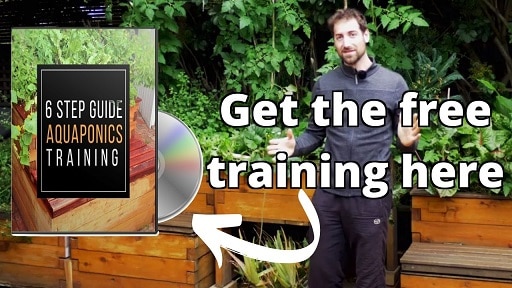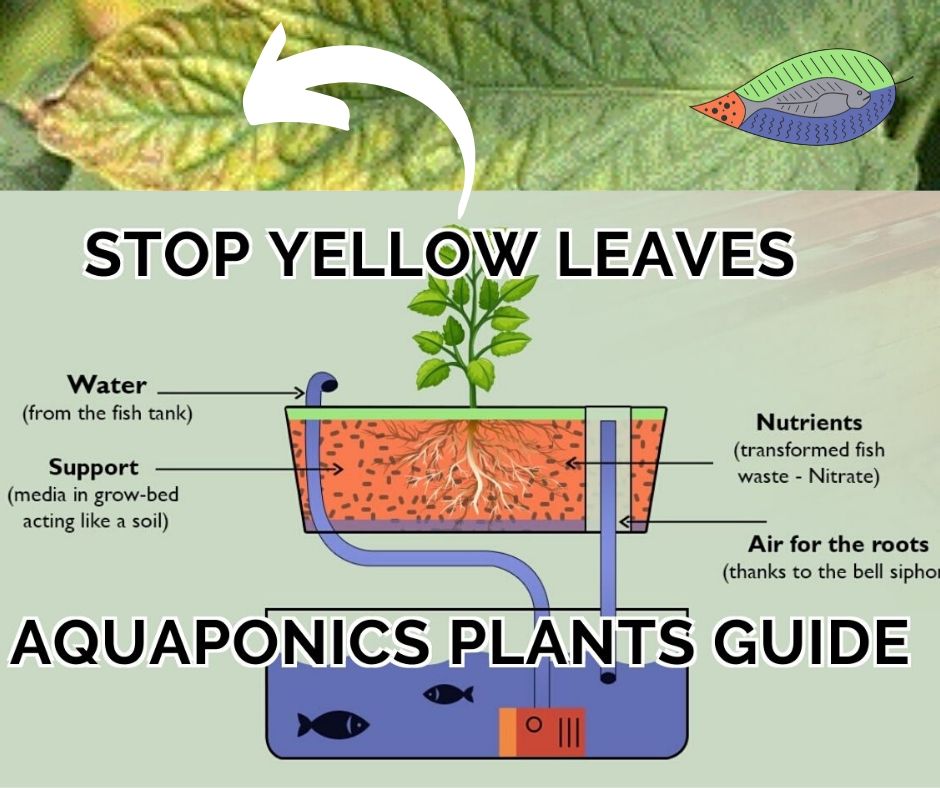You want to grow plants in aquaponics? Good idea! In aquaponics we integrate fish and plants culture. Here is a guide to help you succeed at aquaponics plants and vegetables production.
The role of plants in aquaponics
When we grow plants in a classic garden, the main role is generally to harvest a nice crop.
In aquaponics however, the role of plants goes beyond the vegetables production. Yes the aim is to grow an healthy crop. But it is also to consume the “plant nutrients” (nitrate) and to somehow “purify” the water for our fish. We grow plants in an ecosystem. The aim is to grow them in “harmony” with the rest of the system.
Plant needs in aquaponics
example of a flood and drain aquaponics system

Plants need 5 main elements for their life. in aquaponics we fulfil those needs as per below:
- Support (media in grow-bed acting like a soil)
- Sunlight and appropriate temperature (make sure there is enough space between the plants)
- Nutrients (transformed fish waste – Nitrate)
- Water (water from the fish tank)
- Air for the leaves but also for the roots (thanks to the bell siphon)
When should you add your first plants…
I very often receive the question “How long to wait before planting in aquaponics?” If you are an aquaponics beginner, you are probably eager to add your first fish and plants to complete the ecosystem. I can totally understand that since I am going through this same feeling every time I build a new setup. However, new aquaponics systems are going through a “cycling process” of several weeks. The cycling process allows the good bacteria to grow on your media. I only recommend to add the fish once the cycling process is over.
What about the plants? I like to add the plants when all good conditions are met to ensure a good plant growth. As we have seen in the previous paragraph, plants need Nitrate to grow. Hence, we must wait the end of the cycling process to add our first plants. In other word, a good month after the aquaponics system creation.
What plants for aquaponics…
There are different types of aquaponics and all have their specificities. In a flood and drain aquaponics system, plants are growing on a grow-bed filled with media. Hence, the plants roots are growing on a media similar to a soil. In Deep Water Culture (DWC) however, the plants are growing on rafts and the roots are hanging into the water. As you can understand, this is different types of environments and living conditions. Hence, we must take this in consideration when we choose our plants.
You may wonder what type of plants can grow in aquaponics? my response is simple: “Most plants grow well in aquaponics“. However, it is true that some plants will struggle in an aquaponics environment. Hence, here is a list of 2 types of “extreme plants” that I don’t recommend in aquaponics:
Dry plants who can’t handle a moist environment:
Technically it is possible to grow Cactus, Succulents, rosemary… on an elevated media. But honestly, those plants are so easy to grow in a classic garden. The aquaponics setup is not justified. They are often classified as “worst plants for aquaponics“.
Plants who require a low or high pH:
In aquaponics we grow plants in a whole ecosystem. Fish, bacteria and plants are living together. Hence, we maintain parameters acceptable for all of them. As a result, pH is generally kept close to neutrality. Indeed, a pH of 7 is the best compromise for all living creatures of the aquaponics ecosystem. Therefore, plants requiring extreme pH will not be suitable for the aquaponics grow-bed. Among those plants we have: Begonia, Rhododendron, Azaleas, Blueberry, Gardenia…
So, I told you that most plants can grow in aquaponics and we went through the few plants not recommended. Now let’s go through a few plants giving amazing results in aquaponics…
Best plants for aquaponics
Some plants are literally bursting out of the aquaponics grow-bed. They are generally plants like mint, watercress, turmeric… which enjoy high moisture and nutrients. If you have a large aquaponics system I would even recommend to be careful when adding them. Indeed, they can simply take over the whole grow-bed. However, if you harvest them often and manage the roots, they are among the best plants for aquaponics.
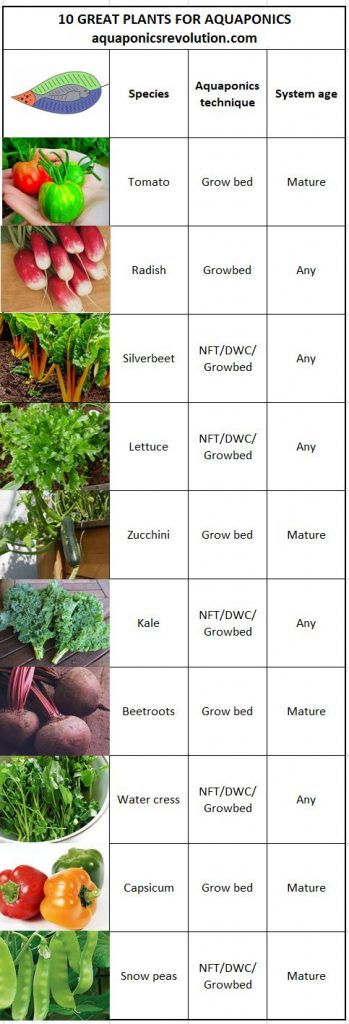
10 Great Plants for Aquaponics
Selecting your aquaponics plants
Now that we know what type of plants can grow in aquaponics, let’s see which ones to select for your specific system. Here are the factors to take in consideration:
1. Climate, geographical zone
Take in consideration the temperature variation of your local climate. Each plant has a specific temperature range and can only live in specific countries. I recommend to check the “Hardiness Zone” of your location. Then you will be able to find plants able to grow in your specific location.
2. Season
All gardeners know that the garden is following the seasons. if you live in the equator you are probably not affected by this point. However, if you live a bit further North or South, you must take it in consideration. You must plant your seeds at the good season or they will never grow. As an example, tomatoes will not grow in winter. You can discuss with your neighbor gardeners and see what they are planting. You can also ask your local garden shop.
3. How old is the system
In a mature aquaponics system (older than 6 months), the biodiversity of insect and bacteria is rich. Hence, a multitude of nutrients are available to the plants. As a result, we can grow a variety of plants including fruit plants. However, in a young system freshly cycled, we don’t have this biodiversity yet. Hence, we can only grow leafy plants less demanding in nutrient diversity.
4. Ornamental/edible/both
Finally, what type of plants are you wanting to grow? What is the aim of your aquaponics garden? Do you want an aesthetic garden to improve the beauty of your backyard or is your aim to produce an edible crop? Good news you can often achieve both with plants that are in the same time edible and beautiful.
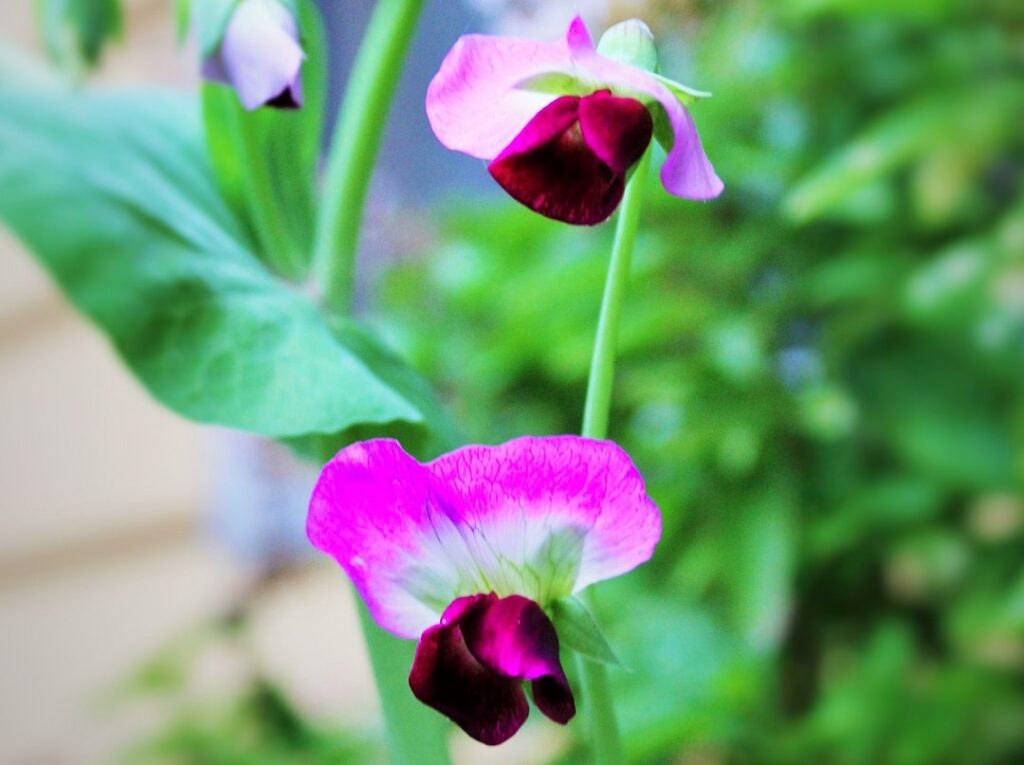
Where do you get them from
Depending on the type of aquaponics technique you are using, there are different options to start your plants.
If you grow plants in Deep Water Culture (DWC) or Nutrient Film Technique (NFT), you will need to work from seedlings.
You have 2 options to get your plants seedlings:
Growing from seeds in a classic plant nursing system
The first one is to grow them from seeds following classic plant nurseries methods. However, we will not use any chemical or pesticide to do so.
Buying seedlings from the local garden shop
The second option is to buy seedlings from your local garden shop. If you chose this option, make sure to follow the recommendations from the next paragraph. It is crucial information to follow before planting them in your aquaponics grow-bed.
If you have a Flood and drain aquaponics system, then you also have the possibility to grow your plants from 2 other options:
Growing from seeds in the aquaponics grow-bed
The advantage of a flood and drain aquaponics system is that the grow-bed media replicate a soil. Hence, we have the possibility to grow seeds directly in the grow-bed.
Indeed, It is often better for the plants to be grown directly into the grow-bed. Hence, you don’t need to transfer the plants and it preserves the roots from stress and risk to be broken. However, the success rate is not 100% neither.
When you sow seeds into your aquaponics grow-bed, they will lay into the space between the media particles. Seeds need to be well fixed to achieve germination.
A major factor influencing the possibility to grow plants from seeds is the media size. If the size of your media is small, the space between the particles will be narrow and the seeds will be well fixed. It will ensure a good success rate.
If the media is large, the space between the particles will be wide and the seeds will not be well fixed. They could even fall deep into the grow-bed with the water level variation. Hence, the success rate wouldn’t be great. Hence, if you chose a large media and want to grow plants form seeds, I recommend to use cotton watt. Indeed, you can wrap your seeds with cotton wrap and it will fix the seed. Thus, you will improve your success rate.
Growing from cuttings
Flood and drain aquaponics is an excellent environment to grow plants from cuttings. While developing new roots, the plants need easy access to water, oxygen and nutrients to survive. The growbed of a flood and drain aquaponics system is offering these conditions. Some plants are more responsive to cutting propagation than others. However, this technique is giving excellent results and is free. I even grow plants for my classic garden from cuttings done in the aquaponics growbed.
Planting
Before the physical act of planting, we must plan the best area for our plants.
Aquaponics is very productive. The limit to plant growth is generally the light access.
Spacing
Hence, I recommend to give enough space to large plants to allow them a nice development. Some plants can grow vines. I place those on the side of the grow-bed. It will allow them to fall outside of the grow-bed. You can also hang them on cables and other types of support.
Wind and sun exposition
Make sure your aquaponics plants have access to enough sunlight and will not be damaged by the wind. Please note that some plants prefer a lower light and will give best results in partially shady area.
This point is also relative to the position of the aquaponics system by itself.
The planting techniques are close to the method used in classic gardens with little variations. Here are my tips for planting your aquaponics seedlings:
Planting homegrown seedlings
If you grow your seedlings from seeds yourself, you haven’t used any pesticide to do so. Hence, when you replant the seedlings into your aquaponics garden, proceed as following:
- Digg a hole into the media (you can use a little shovel but be careful to not touch the growbed liner if any)
- Place your plant (with the less earth material possible)
- Top up the hole with media
Bought plants from the garden shop
If you have bought your plants from the shop, we are not sure of the type of products (chemicals, pesticides) used by the nurseries. Hence, we will use the following method:
- Remove the extra earth around the roots, living enough to not stress the plants. In other words, remove the pot and shake the superficial earth until you see the first roots. An easy way to remove the extra “soil” around the roots is to shake it in a bucket of water. You can also use a simple water hose. Be careful however to not remove all the soil around the roots. Naked roots are weaker. There are 2 reasons why we remove the extra earth:
- First, to avoid an excess or organic matters into the grow-bed
- Second, to avoid the possibility of pesticides from the nursery.
- Before planting those seedlings in your aquaponics system, I would also recommend to spray the foliage with water. We want to wash any possible pesticide from the leaves.
- Digg a hole into the media (you can use a little shovel but be careful to not touch the growbed liner if any)
- Place your plant
- Top up the hole with media
What quantity of plants for your aquaponics system
When you begin aquaponics you may wonder how many plants per fish you should have. It’s a smart way of seeing things. I could stop this paragraph by simply telling you to stick to a feed/plant ratio. A good range would be 30 – 80g of fish food per square meter of plants. However, the quantity of plants is often limited by the space available. Especially if you are using flood and drain aquaponics.
Nutrients
In theory, the quantity of nutrients available for your plants is linked to the quantity of fish in the system. However, in practice, nutrients are rarelly the limiting factor in aquaponics. In fact, we often produce more nutrients than the plants can absorb. We even use the aquaponics water as free nutrients for the classic garden.
Space
The real limiting factor in the quantity of plants to keep is often the space available to plant our crop. In a flood and drain aquaponics system, we size the grow-bed in relation to the maximum fish quantity (fish biomass). Hence, we know that we have enough bacteria for the quantity of fish. As our grow-beds are generally 30cm deep, it gives a specific ratio of growbed space per maximum kg of fish. Talking numbers we have:
Maximum fish density per growbed volume: 1kg fish / 50L grow-bed.
Grow-bed depth generally 0.3m. one square meter of grow-bed=300L.
Hence, 300L / 50L = 6kg of fish.
The ratio fish/plant surface is: Maximum 6kg of fish per square meter of plant grow-bed.
The good approach
The above values are general limits only. Each aquaponics system is different in function of the species, size and temperature.
The real indicator is the level of nitrate. If it’s too low, you may want less plants per fish, if it’s too high, you may want more plants.
General problems faced in aquaponics
We have seen that plants have a number of needs. if we don’t fulfill the plant needs, we face issues. some of them are:
Rotten roots
The reason of this symptom is very often a poor aeration of the roots. It can also be due to a grow-bed maximum water level too high. Indeed, some plants don’t like to have the neck (section between the roots and the aerial part) in contact with moisture. In this case you can fix the problem by adding more media or setting the bell siphon to a lower maximum water level.
I often see beginners building flood and drain aquaponics systems without bell siphon. Constant level grow-bed can only work for certain aquatic plants. most others will not be able to grow in those conditions.
Plants affected with disease
I will not develop this topic deeply here since you have an aquaponics pest control guide here. However, if you see fungus growing on your plants, it may also be due to a high moisture level on the surface of your media. Once again, you can fix this issue by adding more media or changing the settings of your bell siphon.
Plants growing slowly or not growing
If your plants are planted at the good season but are not growing, it can be a lack of nutrients or sunlight. Assuming you have positioned your crop properly, check your nitrate level. If nitrate are too low, you may want to add more fish.
Leaves turning yellow
Yellow leaves also known as chlorosis. They are a common problem in aquaponics. It is generally linked to a mineral or nutrient deficiency. If your aquaponics water nitrate level is low (below 7 ppm), it may be the cause of chlorosis. However, yellow leaves are more often due to a lack of essential minerals. Among all the minerals needed by the plants, iron (Fe 2+) is one of the most tricky to maintain in aquaponcis. Indeed, in presence of oxygen and moisture, it turns into rust (Fe3+). Plants can’t absorb rust. However, in aquaponics we add a special form of iron called “chelated iron” to fulfill our plants needs.
Hence, if you experience yellow leaves, see the article about aquaponics water quality here. It will allow you to manage your water parameters correctly. As a result, you will be able to offer appropriate conditions to your plants.
Plants maintenance
I told you that aquaponics was a very easy way to grow food and you don’t have to spend hours working in your garden. However, there is a little bit of love to give to your plants. Nothing too time consuming but it’s required if you want to maximize the food production. here are the 3 main action required
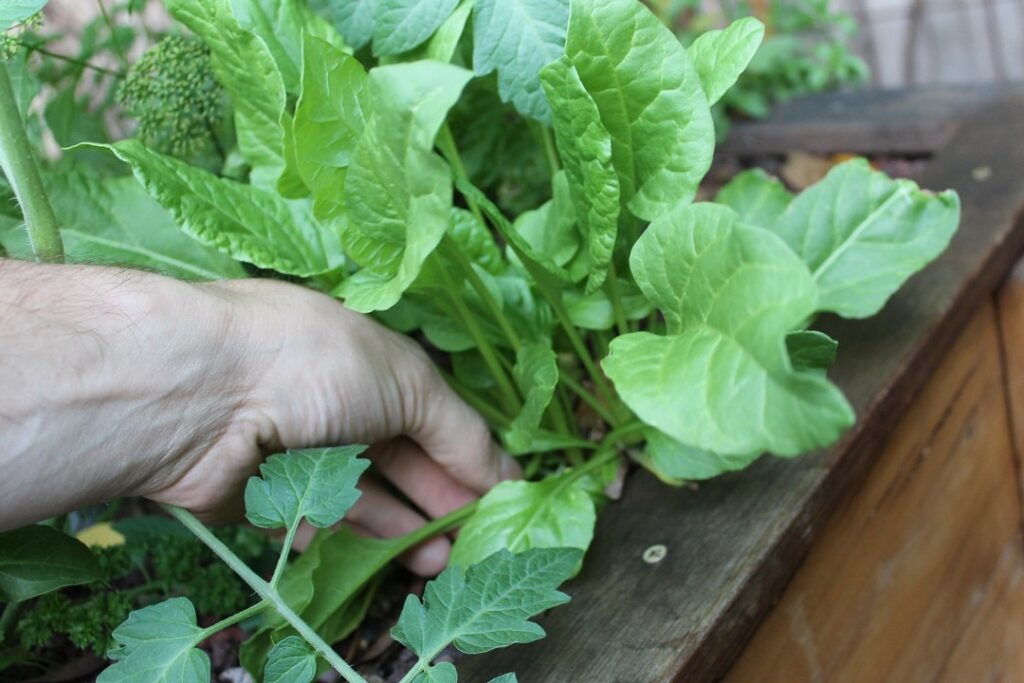
Harvesting your crop
Harvesting your crop doesn’t seem much and it’s the purpose of aquaponics. However, it is a good thing for your ecosystem. Since you constantly feed your fish and add nitrogen (fish food) in the system, it’s important to remove it as well. If you leave your crop in the system, at one stage the nitrogen level will raise and affect your fish. Hence, it’s good to harvest ripe fruits and leafy plants before they get too old and release nitrogen back.
For leafy plants I use an interesting harvesting technique. Instead of harvesting the whole plant, I collect the older leaves and leave the young ones in the middle. Hence, a salad can keep producing for months. This technique increase productivity and decrease the necessity of new seedlings.
Trimming
If you are growing crop that can grow in a vine such as tomato, It’s good practice to cut the suckers as often as possible. it’s not a mandatory measure. But if you can direct one vine away from the grow-bed, you will offer more light to other plants. Hence you will produce more.
Tie plants to prop
In the same concept as trimming vines, you want to tie vines to props. it will help to keep them away from other plants and share the sunlight. But also, by tying the plants, you avoid them to spend energy to hold their own weight. hence, they can produce more leaves and fruits.
What plant growth can you expect from aquaponics
It is common to read that aquaponics plants are growing twice as fast as in a classic garden. To be honest, it really depends on the type of garden you are comparing it to. In aquaponics the limiting factors to plant growth are temperature and sunlight.
Here is an interesting experiment where you can compare classic soil growth and aquaponics.
How to improve your plant production in aquaponics
Temperature and sunlight are often the limiting factors to aquaponics plant production. Hence, building your aquaponics inside a greenhouse will significantly increase the production. Here are the main advantages of greenhouse:
- They keep the temperature and allow to extend the seasons.
- They also spread the sun-rays and diffuse the light. Hence, plants are not competing for light as much.
Another possibility is to connect your aquaponics system to some kinds of auto-fed wicking beds or dutch buckets. As long as your filtration allows it, you will be able to increase the quantity of fish and to produce enough nutrients to feed those containers. it will increase the planted surface, hence a larger production.
If you want to learn more about aquaponics and start your own system, I recommend you to get access to my free 6 steps training to build and manage an Aquaponics system. Click here to access for free! Thanks and good reading 🙂
